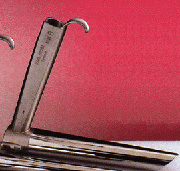Equipment used for microlaryngeal surgery
Laryngoscopes
There are several types of instruments that are extremely important for microlaryngeal surgery. First, an instrument called a laryngoscope is used to bring the vocal folds into view.
The patient undergoing surgery will usually be fully asleep and lying on one's back. The laryngoscope is inserted into the mouth and passed down the throat until it sits just above the vocal folds. Because the surgery is done through the laryngoscope, it is preferable to use as large a laryngoscope as possible (this gives more room in which to work). In the ideal situation the entire length of the vocal folds will be easily seen without much force on the laryngoscope. However, in some people the positioning can be difficult and portions of the folds (especially towards the front) may be difficult to see. There are many different types of laryngoscopes that can be used to try to maximize both the exposure of the vocal folds for the surgeon.
The image to the left shows an example of a laryngoscope. This particular scope is L-shaped; the part sticking up is the handle that the surgeon holds as he or she inserts the scope. The narrow part to the right goes in the mouth, and the surgeon operates through an opening on the left side. Special long narrow instruments (described in more detail below) are passed through the scope down onto the larynx.
In “direct laryngoscopy”, the surgeon is holds the scope in one hand and looks down the laryngoscope at the patient's vocal folds.
The surgeon can then use instruments in the other hand, working through the laryngoscope. The operating arrangement is useful for inspecting the throat and getting an overall view of the larynx.
However, for actual surgery on the vocal folds, a more magnified view is necessary. Delicate surgery on the vocal folds is best done under high magnification. Special operating microscopes and endoscopic telescopes are used to magnify the folds during surgery. The microscope has a large focal length and binocular eyepieces that allows a good three-dimensional view of the folds. One drawback with the microscope is that because surgery is done through the narrow laryngoscope, the upper parts of the various surgical instruments can block the surgeon's view. Special laryngeal telescopes can, in contrast, be placed just above the vocal folds and give unobstructed views of the folds.
Microlaryngeal instruments
Various manufacturers offer specialized instruments used for operating on the larynx. These instruments have a variety of different tips for grasping, cutting, or dissecting tissue. They have to be long and narrow since all surgery is done through the laryngoscope. The ends must be very small, usually only 1 or 2 mm, since the structures on the vocal folds are also tiny.
The surgeon will also commonly use suction catheters and long thin probes or knives to complete the operation.
Anesthesia for microlaryngeal surgery
Almost all microlaryngeal surgeries are done with the patient under general anesthesia. During the surgery the patient must be given oxygen and the carbon dioxide produced in the lungs must be removed. This is usually accomplished by a combination of intravenous medications and the use of anesthetic gases. The gases and oxygen are given by first passing a plastic endotracheal tube through the vocal folds into the upper windpipe. This is called intubation.
When operating on the vocal folds, the endotracheal tube can get in the way. There are a few techniques that can be used to minimize this problem. First, the anesthesiologist can use a very small tube. Second, the tube can be momentarily removed during the operation for a couple minutes and then replaced to supply oxygen and anesthesia while the oxygen concentration in the blood is continuously monitored during surgery. Finally, a type of ventilation called jet ventilation can be used in which the oxygen and gases are blown into the lungs under a higher pressure. Jet ventilation requires either no tube or a very narrow tube and gives the surgeon more room to work. The exact choice of anesthesia depends on many factors.
Risks of microlaryngeal surgery
Microlaryngeal surgery is extremely safe. However, like any surgery, there are some risks. There are slight risks of general anesthesia, especially in individuals with severe heart or lung problems. Specific risks from the laryngoscope include pain and numbness to the tongue due to pressure which is fairly common, some bruising to the lips (also relatively common), and rarely, a chipped tooth. The risks of the actual surgery on the folds depend on the procedure being done and are best discussed with your surgeon.
